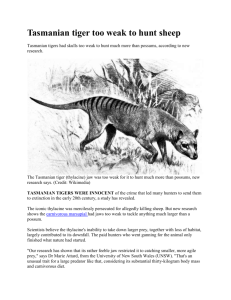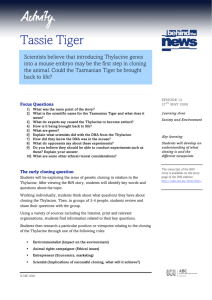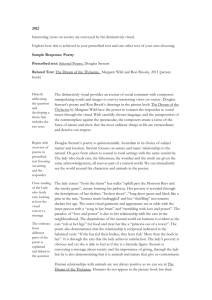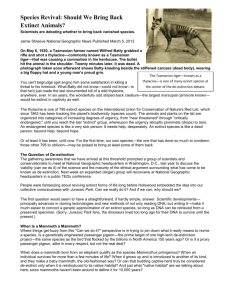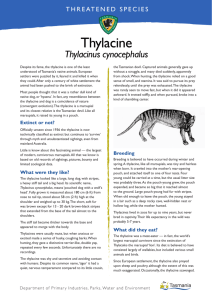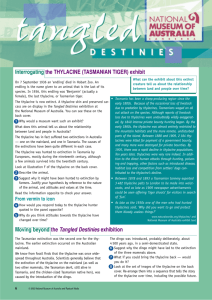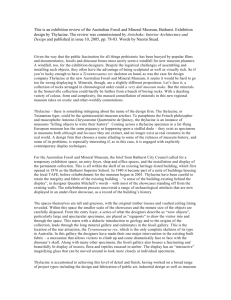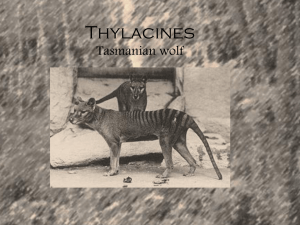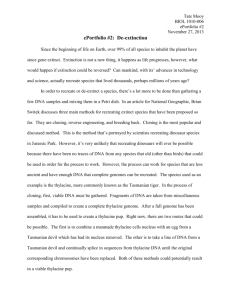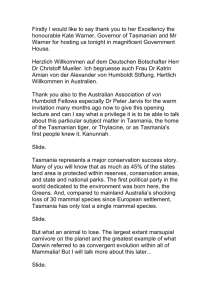Robert Paddle, The Last Tasmanian Tiger
advertisement
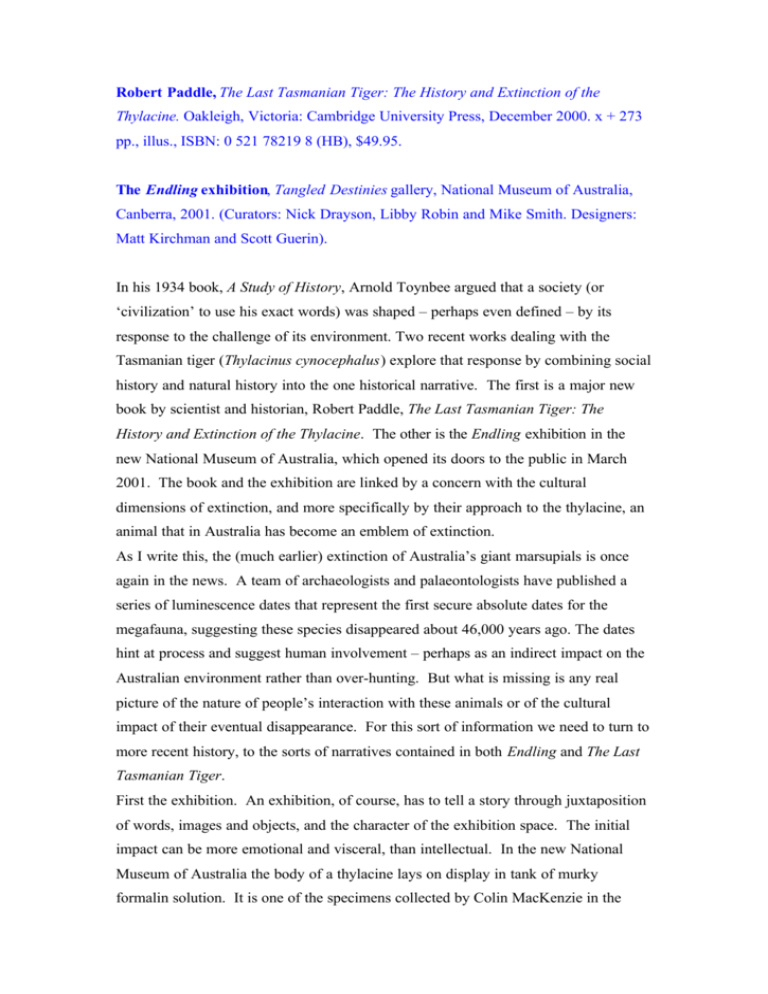
Robert Paddle, The Last Tasmanian Tiger: The History and Extinction of the Thylacine. Oakleigh, Victoria: Cambridge University Press, December 2000. x + 273 pp., illus., ISBN: 0 521 78219 8 (HB), $49.95. The Endling exhibition, Tangled Destinies gallery, National Museum of Australia, Canberra, 2001. (Curators: Nick Drayson, Libby Robin and Mike Smith. Designers: Matt Kirchman and Scott Guerin). In his 1934 book, A Study of History, Arnold Toynbee argued that a society (or ‘civilization’ to use his exact words) was shaped – perhaps even defined – by its response to the challenge of its environment. Two recent works dealing with the Tasmanian tiger (Thylacinus cynocephalus) explore that response by combining social history and natural history into the one historical narrative. The first is a major new book by scientist and historian, Robert Paddle, The Last Tasmanian Tiger: The History and Extinction of the Thylacine. The other is the Endling exhibition in the new National Museum of Australia, which opened its doors to the public in March 2001. The book and the exhibition are linked by a concern with the cultural dimensions of extinction, and more specifically by their approach to the thylacine, an animal that in Australia has become an emblem of extinction. As I write this, the (much earlier) extinction of Australia’s giant marsupials is once again in the news. A team of archaeologists and palaeontologists have published a series of luminescence dates that represent the first secure absolute dates for the megafauna, suggesting these species disappeared about 46,000 years ago. The dates hint at process and suggest human involvement – perhaps as an indirect impact on the Australian environment rather than over-hunting. But what is missing is any real picture of the nature of people’s interaction with these animals or of the cultural impact of their eventual disappearance. For this sort of information we need to turn to more recent history, to the sorts of narratives contained in both Endling and The Last Tasmanian Tiger. First the exhibition. An exhibition, of course, has to tell a story through juxtaposition of words, images and objects, and the character of the exhibition space. The initial impact can be more emotional and visceral, than intellectual. In the new National Museum of Australia the body of a thylacine lays on display in tank of murky formalin solution. It is one of the specimens collected by Colin MacKenzie in the 1930s for the former Australian Institute of Anatomy. ‘Time is a factor’, said Mackenzie, ‘for the fauna is fast disappearing, and every specimen is of importance.’ His concern was to preserve study specimens rather than the species but he also played a significant role in wildlife preservation by creating the Healesville Sanctuary for Australian animals. The National Museum’s thylacine is partially flayed and eviscerated. Even so, it is an emotional rather than horrifying sight to look at this young adult male Tasmanian tiger. The animal has a rather beautiful face. The feet, paws and tail retain their skin and fur. As the young thylacine lays in repose in its tank, it might almost be something more deeply familiar: the family dog perhaps. Most of us encounter extinct animals only as skeletons, study skins, or as mounted taxidermy specimens. The immediacy of an almost complete animal with its soft tissue intact is startling. Looking into the face of the Museum’s ‘tiger’, extinction ceases to be an abstract scientific idea and becomes a more intimate concern, a part of recent history. Across from MacKenzie’s thylacine there is the skin of another thylacine, an old animal trapped in 1930 and probably one of the few remaining wild thylacines at this time. The museum exhibition reconstructs the history of this thylacine: the life of the animal, the story of the trapper Charles Selby Wilson a government surveyor on the rugged west coast of Tasmania in the 1920s and 30s, and the subsequent use of the skin as floor or wall covering in various Wilson family homes, where it saw some rough usage. In 1987 Wilson’s descendants sold the skin at a church auction and it was acquired by a local art dealer who ‘felt sorry for it’. This reflected a broader shift in public attitudes towards the (by now extinct) species, from vermin to icon, as the animal became emblematic of extinction and of the Tasmanian wilderness. The skin was later exhibited at the opening of the new Cascade Brewery in Hobart alongside the company’s trademark: a thylacine. Its passage to cultural icon was completed with acquisition of the skin for the National Historical Collection. Above both thylacines, written in large letters on the wall is a definition from Nature of the ‘last word’: ‘Endling (n.) The last surviving individual of a species of animal or plant.’ Over 100 species of plants and animals have vanished from Australia since Europeans came here to settle. And of all the mammal species that have disappeared from the planet in the last 200 years, half have been Australian. The Endling exhibit sits in a galvanized iron mausoleum, engraved with the names of these species – and others endangered but not yet extinct. The loss of native species and habitat made a deep impact on the thinking of settlers, promoting an early concern with nature conservation and its counterpart: the memorialization of loss, eloquently summed up by poet Les Murray in his lines: ‘The first extinction, the regretful regretted.’ In The Last Tasmanian Tiger, Robert Paddle traces the shifting values and responses in more detail. His book opens with a truly memorable quote: Species finally depart the biota, not with a bang but a whimper. The thylacine ...is one of a handful of species where that whimper has a precise date. …7 September 1936 when the last known specimen died in captivity in the Beaumaris Zoo, Hobart. He traces the history of scientific and popular thought about the thylacine and the politics associated with its eventual extinction. Ostensibly his method is post-modern, ‘constructing a narrative of the thylacine’ and seeking out the ‘ambiguities, silences, real omissions, pretended omissions and contradictions in the literature.’ But his book is best described as a thoughtful search for the context in which ideas about the thylacine and its biology have been formulated and promulgated. The book opens with an historical account of how scientific ideas about the thylacine and its biology and behaviour developed. This part of the book is patchy: Paddle relies on secondary sources for his archaeology and late Quaternary history and there are a few glaring errors (Did Thylacoleo, the marsupial lion, really survive as recently as 10,000 BP?). The author’s iconoclasm also leads him astray here, arguing that scientists have been blinded by their preconceptions to the late survival of two relict mainland populations of thylacines (Where are the sub-fossil remains?). His own theoretical undergarments also show through more strongly than is decent, as he conducts a ‘summary trial and execution’ of colonial scientists, on what often seemed to me to be very slim evidence, for cutting their science to fit their preconceptions. Paddle is stronger when he moves on to examine the history of specific misconceptions about thylacine behaviour (fish eating; blood feeding; and predation on sheep), and the fate of local naturalists such as R. C. Gunn in Tasmania who was ostracised by metropolitan science for contradicting international expert opinion about the diet and feeding behaviours of the thylacine. On other aspects, Paddle is able to use the historical record to significantly add to knowledge of thylacine behaviour, uncovering previously overlooked evidence that the animals made lairs, and also showing that the behaviour of thylacines changed as the impact of colonial settlement was felt. Early in the historical period, observations suggest an animal living in family groups, with cooperative hunting, an established home range and a range of vocalizations consistent with a social animal. Only later did thylacines become the solitary hunters of popular imagination. In the second half of the book, Paddle gets into his stride, with a strong study of how the fate of the thylacine became entwined with local politics. Prior to 1829 there are few accounts of ‘tigers’ preying on sheep. But by 1830 the Van Diemen’s Land Company was seeking to justify poor returns and high stock losses to British investors. The thylacine was a convenient scapegoat. The company introduced a private bounty scheme (1830-38) ostensibly to reduce the number of thylacines on its properties in north-west Tasmania. In the 1840s Australia’s first major rural depression exacerbated the problem and the bounty scheme was extended, running until 1849. Although scientists, politicians and many rural landlords were sceptical about claims that the thylacine was a major threat to sheep, destruction of these animals became part of the shaky rural political platform of politician John Lynne. From 1880, when he became a member of the Tasmanian House of Assembly, Lynne waged ‘a war of attrition’ to introduce the thylacine into parliamentary debate, largely against the wishes of the government of the day. Once again the thylacine became an excuse for poor farming practice – and was widely seen as such at the time. It became a pawn in a political struggle between the rural lobby and parliament, whose members often questioned the validity of the sheep farmer’s statistics. In 1886 the Tasmanian Government changed. In a period of shifting political alliances Lynne pushed through a government bounty scheme for destruction of the thylacine. From this perspective, the eventual extinction of the Tasmanian tiger was more the by-product of cynical political manoeuvring between rival interests in colonial society than any direct clash between the needs of settlers and thylacines. In 1871, Tasmania was the first Australian colony to pass a bill for the destruction of rabbits. However, even at the time it was a much larger step to arrange for the deliberate destruction of a ‘native’ species. Mirroring his earlier account of the politics of extermination, Paddle moves on to examine the politics of wildlife preservation. In 1895 the Tasmanian Game Protection and Acclimatization Society had been formed. By 1901 there was a growing conservation movement, fuelled by the difficulty of obtaining thylacine specimens for overseas zoos and museums. However, bureaucratic obfuscation delayed any measure to protect the Tasmanian tiger until 1936, when the Tasmanian Fauna Board declared the species a protected animal. Paddle dryly comments: ‘...the species was totally protected for the last fiftynine days of its existence.’ The narrative then shifts scale from species to individual to examine in some detail the history of the last thylacine, an animal that died in the Beaumaris zoo in Hobart in 1936. Much of the story here hinges on the curator of the zoo, Arthur Reid, and his daughter Alison Reid. As the Great Depression set in, the Tasmanian government sought to reduce the expenses of the zoo by cutting the number of employees and reducing the salaries of those remaining. Alison Reid, a ticket collector, was one of those who lost her job, but she stayed on in an honorary capacity single-handedly caring for animals when her father was crippled after being assaulted in the zoo grounds by a thief. After Arthur Reid’s death in 1935, the Reserves Department refused her application for the post of curator position. It would not countenance the appointment of a woman, though it is clear she was the most qualified applicant. It stripped her of the keys to the zoo and moved to evict Alison and her mother from the curator’s cottage where they had lived for 14 years. With no one left to care for the animals, the zoo animals died one by one of indifferent feeding and exposure. When the last thylacine died, Paddle comments: it was ‘as much a victim of sexual as species chauvinism.’ In his conclusion, Paddle returns to his post-modern script, arguing rather ingenuously that scientists need to publicly explore the implications of their data. What is more significant in this powerful study is the way it shows how political and bureaucratic manoeuvring within settler society can have major (often unconsidered) consequences for the Australian biota. The fate of species like the thylacine may be incidental to wider issues at stake such as rural depression, cost reduction and individual political careerism. In some ways the thylacine – with its superficial resemblance to a wolf or tiger – suffered from the folklore attached to these placental mammals and was easily misrepresented, as a dangerous predator, for the wider ends of second-rate provincial politicians. These two works – one a book and the other a museum exhibit – powerfully demonstrate the value of bringing together an understanding of the dynamics of natural systems and species, with a strong historical perspective on the development of scientific ideas, changing popular values, beliefs and mythologies, and their interaction with the political structures of settler societies. References: Bonyhady, Tim The Colonial Earth, Melbourne: The Miegunyah Press, 2000. MacKenzie, Colin ‘Australian Fauna and Medical Science’, Royal Society of Tasmania Papers, 1925, 203-8. Murray, Les ‘The newly tragic Dodo’, in Conscious and Verbal, Sydney: Duffy & Snellgrove, 1999. Roberts, R. G., T. F. Flannery, L. K. Ayliffe, H. Yoshida, J M. Olley, G. J. Prideaux, G. M. Laslett, A. Baynes, M. A. Smith, R. Jones, B. L. Smith ‘New ages for the last Australian megafauna: Continent-wide extinction about 46,000 years ago.’ Science 292, 2001, 1888–92. Toynbee, A. J. A Study of History, Volume II. London: Oxford University Press, 1934, 1-72. Webster, R. M. and B. Erickson ‘The last word?’, Nature 380, 1996, 386. Mike Smith National Museum of Australia Canberra Editorial note: Robert Paddle’s The Last Tasmanian Tiger was awarded the 2001 Whitley Medal by the Royal Zoological Society of New South Wales as this essay went to press. Courtesy Historical Records of Australian Science 13(4), 2001. http://www.science.org.au/hras/
